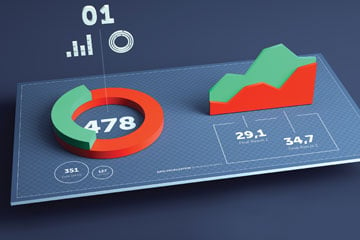Showing legal information in a more visual format has many benefits, but it can also be misleading.

Showing legal information in a more visual format has many benefits, but it can also be misleading.
Dan Roam wrote a book back in 2008 called The Back of the Napkin. It quickly became one of my essential reference books on my bookshelf. It seemed to give me permission to be terrible at drawing but at the same time to keep at it when words and numbers don’t work. And, sometimes, they don’t. In fact, recent studies suggest that by combining pictures and words (or numbers), we can achieve a deeper level of understanding than if we used either pictures or words alone. Combining text, numbers and visuals to draw deeper insights from text-bound law is behind the oncoming legal tidal wave of “data visualizations” (or “dataviz” as the cool kids call it).
Recent research identifies two trends for dataviz: first, the sheer growth in data and information that must be processed for new understanding and decision-making; and second, the increase in visual learners and thinkers. The blame for this increase lies in our new Instagram-like communication modes and the prevalence of touch-screen technologies. Together they create more visual interactions and experiences than reams of paper-based text and numbers ever did.
Turning the dots of data on a page into an infographic or chart has the potential to illustrate new and different insights. There are some famous examples of this, such as “The Billion-Dollar-Gram” by the Information is Beautiful website. It is an excellent example of visualizing data to provide new context. “289 billion spent on this. 400 billion spent on that. When money reaches this level it literally becomes mind-boggling. Yet these figures are regularly issued by the government — and the media — as if they are self-evident facts that everyone understands.” David McCandless created the visualization to put these huge numbers in perspective and to create deeper meaning along the way.
Tables of numbers ask the reader to find patterns and draw their own conclusions. In contrast, the authors behind visualizations create connections on our behalf. They lead us to the insights that they have uncovered. We aren’t forced to study and interpret the facts and figures to draw conclusions. But it also means we need to apply a more discerning eye to dataviz, infographics, charts and dashboards when we come across them. We need to ask ourselves whether we completely understand what we are seeing in the data.
The tools for translating data into visuals are now easy and cheap; anyone can now convert a spreadsheet into a pretty chart with the click of a button. And some of those charts and visualizations are pretty awful as a result. Head over to the Junk Charts blog (among others) to see some hilarious, and often worrying, examples of how easy it is to misinterpret data and draw wrong conclusions. This has led to calls for a “visual grammar” to apply rigour when creating such graphics. And as readers we need a visual literacy to engage deliberative and logical thinking when faced with a chart; something to uncover discrepancies and questions about what the data says and the conclusions to which it comes. Edward Tufte, who wrote two of the best books on visualizing quantitative and qualitative data, said not all data visualizations illustrate “answers.” Instead, they’re there to “provoke thought.” It’s a useful guideline when faced with dataviz.
What is the purpose or context of the visual or diagram? What is the author trying to get across? What is the data telling you? What data is missing or not represented? How reliable is the data? What is the sample size of the data?
The ongoing use of visualizations in law to communicate and convey new meaning requires us to engage with information in new ways. We need to apply a new degree of confidence in trusting the data beneath and the story it seems to be telling us.
Most of the dataviz to date has been in the legal research/search arenas. And it is set to get infinitely more interesting through a bunch of startups and smaller legal research services (largely U.S. based at this stage). They are experimenting with visuals and interactions that can better distinguish results. And thank goodness, frankly! There is a monotonous tone and look to our current search results pages — every hit looks as relevant as the one before and after it.
Ravel Law, for example, draws a visual map of your search results. The map shows relationships between cases and how important they are to one another. They use visual cues such as size of the circle (cases are bubbles in the new paradigm), the colour and the proximity and number of connections to other bubbles. These visualizations and cues can say so much more than that monochromatic page we have now.
LexisNexis is experimenting with different methods to visualize the number of times your search terms appear in search results. They use colour and navigational cues to help us understand relevancy in new ways. And Westlaw’s KeyCite service tracks the path of a case through successive courts and the decisions made at each level in a clear and interactive graphic.
Citations and precedents lend themselves well to visualizing cases along simple timelines. Services such as Fastcase plot search results along a visual timeline (say goodbye to “Sort By . . . ” dropdowns!). And they track citations to show the progression of precedents through the courts. Prominent search results should jump out at you, along with the connected cases just a click away for deeper investigation. As Roam says: “Visualizations should jolt with insight.”
Still, the development of new and exciting visualization technologies needs to progress at the same rate as our visual understanding of that data. We must continue to question how relevancy is calculated, which courts are included in the data set, and how far back it goes, to identify our “degree of confidence” in trusting the story being told.
Other dataviz examples are being driven by the e-discovery and analytics markets. The need for more creative ways to sort and organize the “big data” for review has spurred new and innovative ways of visualizing connections, identifying patterns and spotting gaps. The legal analytics market is also exploring dataviz. They tell stories about success and failure rates and predict possible outcomes based on digesting the data we have about the past.
These visualization innovations are finding their ways into our law firms, on to dashboards, into charts and the tools we use for decision-making. And as long as we continue to adopt a healthy degree of skepticism when relying on the visualization stories we are told, we will enjoy a greater level of dataviz than many of the visualizations that, as websites like viz.wtf put it, “make no sense.”
Kate Simpson is national director of knowledge management at Bennett Jones LLP and is responsible for developing the firm’s KM strategy and initiatives. Opinions expressed are her own.











